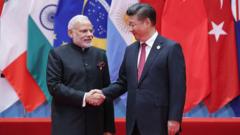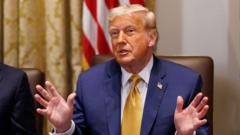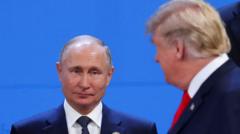With geopolitical shifts prompting India to engage China, recent visits by senior officials signal attempts at reconciliation. Yet, persistent territorial disputes and trade dynamics continue to test relations amid mutual apprehensions.
India and China Navigate a Cautious Path Towards Reconciliation

India and China Navigate a Cautious Path Towards Reconciliation
Despite historical tensions, recent diplomatic efforts indicate a potential thaw in India-China relations, although significant challenges remain.
In a landscape marked by shifting geopolitical realities, India and China appear to be moving cautiously toward a potential reconciliation, as evidenced by recent diplomatic visits and agreements, despite lingering tensions. The complex history between the two nations is significantly influenced by a disputed 3,440km border, which has seen military confrontations, most notably in Galwan Valley in June 2020, resulting in casualties on both sides.
India's National Security Adviser, Ajit Doval, and Defence Minister, Rajnath Singh, recently made notable visits to China. Singh's visit was particularly significant as it marked the first trip by a senior Indian leader to China in five years, coinciding with the Shanghai Cooperation Organisation (SCO) meetings, a regional security alliance that includes Russia, Iran, and Pakistan. These efforts appear to be a strategic pivot, driven largely by India's need to address security and economic concerns amidst an evolving global power dynamic.
Trade between India and China remains robust, with over $127 billion recorded last year, making China India's second-largest trading partner. However, India’s reliance on Chinese imports, particularly rare earth minerals crucial for various sectors, heightens the necessity for stability in border areas. Subsequent to the 2020 skirmishes, both nations have made moves to ease restrictions, such as resuming direct flights and relaxing visa policies.
Yet, fundamental challenges persist. Beijing's increasing focus on Taiwan raises security concerns for Delhi, further complicated by perceptions that Western nations may leverage India to counterbalance China’s growing influence. The Chinese government seeks to enhance its economic foothold in India, pushing for more exports and investments while simultaneously expressing skepticism towards India's expanding ties with the US.
India’s strategic positioning is further tested by its complicated relationship with Pakistan, underscored by military exercises and arms collaboration between Beijing and Islamabad. The diplomatic tensions towards the U.S. under President Trump have left India searching for alternative partnerships, accumulating unease regarding America's commitment to India in future conflicts with China. This dynamic is indicative of a pragmatic approach as India pursues a thaw while remaining cautious not to yield excessively to Chinese demands.
Both nations currently face the challenge of reconciling their territorial disputes, particularly concerning Arunachal Pradesh, which China claims as Southern Tibet. While experts suggest a resolution of these issues is essential for lasting peace, both countries are acutely aware of the implications of sovereignty and nationalism within their respective domestic contexts.
As economic challenges and international alignments evolve, ongoing discussions between India and China suggest a search for a mutually beneficial relationship rather than reliance on global alliances. The trajectory of India-China relations, therefore, remains uncertain, embodying both potential for cooperation and the specter of conflict.





















